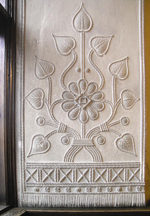
One of the main stairs in Copenhagen Townhall, built 100 years ago. The frieze was designed by the architect, Martin Nyrop. He was inspired by Hedebo Embroidery and designed embroidery patterns himself for the Society for the Promotion if Hedebo Embroidery.
Hedebo Embroidery was beautifully executed by peasant wives from the Hedebo area up until the 20th century. After that, the embroidery was also sewn by wealthy and educated women from both the cities and the countryside. This has led to interpretations that explain Hedebo Embroidery as special because it was a needlework culture which spread from the peasantry to the middle classes. But should the interpretation stop there? How did the peasant wives of the 19th century begin to embroider in such a way that clearly drew on inspiration from Renaissance Italy?
Wet nurses and Maids
Throughout the 19th century, many young women came to Copenhagen as maids and wet nurses. At an exhibition in 1812, a typical bonnet from the Hedebo area was called a wet nurse’s bonnet. Paintings from the Golden Age by Vilhelm Marstrand depicted wet nurses in Hedebo folk costume. This has led to the conclusion that wet nurses from the Hedebo area were highly valued in Copenhagen. Maybe the wealthy, who hired the nurses, thought that the well nourished women from the Heath also had healthy and abundant breast milk. Wet nurses were privileged members of a family – compared to the rest of the domestic servants. This was shown by the wet nurse’s uniform and em-ployment contract. One can assume that the wet nurse also gained a special insight into the bought or sewn embroideries of the lady of the house.
Inspiration
In the 19th century there was a mingling of those who hired wet nurses for their newborn babies in Copenhagen and those who travelled throughout Europe and were inspired by foreign artisan craftwork. One can imagine that the trained embroidery eye of the wet nurse fell on both familiar and new elements among the textiles of the lady, and that the wet nurse would immediately try these out in her Hedebo embroidery. This contributed to the development of new variations and techniques. In the second half of the 19th century, more and more women from Copenhagen discovered the qualities of Hedebo Embroidery. They bought Hedebo Embroidery textiles, now crafted by able needle-women following designs which matched the house interiors and the clothes of the middle classes. At the beginning of the 20th century, it became fashionable for middle class women to learn to sew Hedebo Embroidery according to patterns published by organisations such as the Society for the Promotion of Hedebo Embroidery.
Copenhagen City Hall
In 1907 the Society for the Promotion of Hedebo Embroidery was established on the initiative of the architect Martin Nyrop. In the 1890s he produced drawings of a proposed new city hall in Copenhagen. Hedebo Embroidery inspired his sketches for the stucco and other decorative elements on the staircases and galleries, and in the offices. The decoration of the brass door handles on the main entrance door also reflects the unique embroideries of Hedebo. This decoration can still be seen in Copenhagen City Hall.


